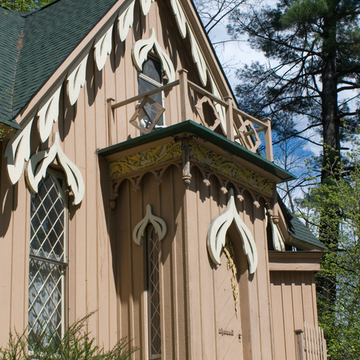Montpelier artist Thomas Waterman Wood designed a Gothic cottage for his bride on a wooded slope just south of downtown Montpelier. Executed by local carpenter Franklin Hoyt, the cross-gabled, one-and-a-half-story, board-and-batten building is a composite of ideas from A. J. Davis and A. J. Downing, distinguished by Wood's original touches. An entrance porch with balcony, centered on the essentially symmetrical facade, is trimmed with a frieze of grape leaves and vines. The motif is repeated as a carved garland on the ogival, diagonally flush-boarded front door, which bears the name “Athenwood” in Gothic letters—a play on the name of the artist's wife, Minerva. Door and window heads are framed with a unique symmetrical tulip-leaf design that recurs on the bargeboards of gables and dormers. Nine-foot-high diamond-paned windows open onto twelve-foot-high first-floor rooms. A diagonal corner bay window looks toward town, and French doors open from the balcony into a long room with a Tudor-arched ceiling with wooden ribs carried on plaster busts of Athena.
Wood was one of the most popular portrait and genre painters of his day, with a main studio in New York City where he served as president of the National Academy of Design and the American Watercolor Society. Until his death in 1903, however, he contin ued to summer and paint at Athenwood. In the 1880s he added a hillside studio with a three-story gabled tower trimmed with barge-boards, finials, and a pine and star porch railing sympathetic to the design of the house. He also added Gothic detailing to other buildings he acquired down the street. Subsequent road changes have diminished Wood's front yard, an original four-gabled cupola and finials have disappeared from the house, and its south wing has been doubled in length. Despite these changes, Athenwood retains much of the special character with which its artist-patron endowed it.







